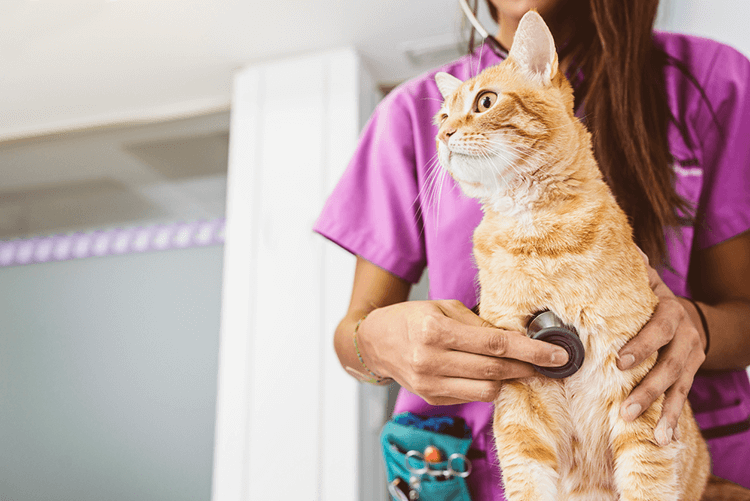FeLV – you’ve probably seen this ominous acronym before, but do you know what it stands for? Or that it affects between 1.48 and 2.28 million cats in the United States alone? It’s true. FeLV stands for Feline Leukemia Virus and it’s something that you should be aware of if you adopt rescue cats, foster cats, or if your cats go outdoors.
WHAT IS FELINE LEUKEMIA VIRUS?
Feline Leukemia virus is a retrovirus that can compromise your cat’s immune system. It’s not cancer! It is, however, one of the most infectious diseases in cats (where we have mono, the “kissing disease,” cats have FeLV, the “friendly cat” disease). There are three types of feline leukemia: FeLV-A, FeLV-B, and FeLV-C. While all cats who are diagnosed with FeLV have FeLV-A (which weakens the immune system) only about 50% have FeLV-B (which causes abnormal growths, like tumors) and only about 1% have FeLV-C (which causes anemia). Any cat who is FeLV+ can more easily catch illnesses or get infections.
HOW DO CATS BECOME INFECTED WITH FELV?
FeLV is incredibly contagious and very easily transmitted – cats can be exposed to the retrovirus simply by interacting with an infected cat through grooming or sharing food and water bowls or litter boxes. Kittens can be born infected with FeLV or become infected while nursing. It can also be transmitted through bites.
It’s important to note that exposure and even an early positive test is not persistent FeLV infection. 30% of cats exposed will not become infected; 30% will test positive for up to 12 weeks but ultimately fight off the retrovirus; and 30% will become persistently infected and face a shorter lifespan. (The last 5-10% may have a latent infection.)
WHAT ARE THE SYMPTOMS?
These are the most common symptoms to keep an eye out for:
- loss of appetite,
- progressive weight loss,
- lethargy,
- enlarged lymph nodes,
- abscesses,
- anemia,
- persistent diarrhea,
- inflammation of the nose or eyes,
- infections of the skin and/or poor coat condition,
- changes in behavior and/or neurological disorders, and
- pale gums or infection (or inflammation) of the gums or mouth.
In about 50% of FeLV+ cats, you can expect to find a fever. Also, some cancers can be caused by Feline Leukemia, such as lymphomas or fibrosarcomas.
DIAGNOSIS & TREATMENT
If you suspect your cat may have the feline leukemia virus (or has been exposed to a cat who is FeLV+), take them in to your vet right away! Just because your cat’s been exposed to FeLV doesn’t guarantee they’re going to become infected themselves, but it’s important to watch them carefully and have your vet evaluate them to be sure.
Generally, your vet will begin with ruling out other explanations for their symptoms. If your kitty’s definitely been exposed and/or the vet decides it’s appropriate, there are two tests they can run to test for FeLV. The first can be done right in your vet’s office and is called an ELISA test; ELISA stands for enzyme-linked immunosorbent assay. If the ELISA test indicates the presence of free FeLV particles in your cat’s bloodstream, your vet can follow that up with an indirect immunofluorescent antibody assay (IFA) test to confirm. While a positive ELISA test may not mean your cat is permanently infected with FeLV, a positive IFA test usually does.
When it comes to treatment, you treat the symptoms and not necessarily the FeLV itself. There is no cure. However, treating any illnesses or infections promptly, doing a special diet, keeping your cats parasite-free and indoors, etc. can keep your FeLV+ cat comfortable and content. Occasionally, hospitalization or blood transfusions may be necessary in the event of severe infection or anemia (or other symptoms or complications).
Most importantly, an FeLV+ cat must be segregated from uninfected cats in your household. They should not share litter pans or food and water dishes between them. Also, if you have multiple kitties and one turns up FeLV+, you should have all of them tested.
DON’T PANIC!
The first thing to do when you’re worried you have a cat with feline leukemia virus is this: DON’T PANIC! Whenever you bring a new cat into your home, just make sure they’ve been tested before they mingle with your other kitties. Keeping your cat protected from FeLV is another good reason to keep your cat inside (here are some others), too. And if your cat will be going outdoors, ask your vet about getting the vaccination.
FeLV may be one of the most common feline infectious diseases, but remember that not every exposure results in persistent infection. Talk to your vet, develop a treatment plan, and limit their potential for future exposure. You’ve got this! And your kitty has you, so there’s a good chance that everything’s going to be okay.
If you’d like to read more about what living with FeLV+ cats is like, check out “Understanding FeLV: Loving and Living with FeLV Cats” by Joni Gallo.






